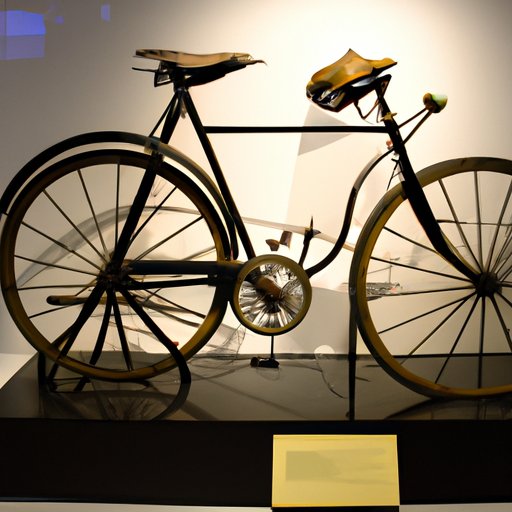Introduction
A bicycle is a vehicle with two wheels that are powered by pedals and steered by handlebars. It is the most efficient human-powered mode of transport, and it has been around for centuries. Today, the bicycle is used for recreation, commuting, and competitive cycling. In this article, we will explore the fascinating history behind the invention of the bicycle, tracing its origin and development throughout the years.

A Historical Look at the Evolution of the Bicycle
Tracing the origin of the bicycle can be difficult, as there have been many different prototypes throughout the years. However, it is generally accepted that German inventor Karl von Drais is credited with inventing the first successful bicycle in 1817.
An overview of the development of the bicycle reveals that the earliest bicycles were made of wood and had no pedals. These were known as “running machines” or “hobby horses”. They were propelled by pushing one’s feet against the ground and steering with the handlebars. In 1860, the first commercial model of the bicycle was introduced and featured pedals. This model was known as the velocipede and it was made of metal. The velocipede was the predecessor to the modern bicycle.

The Invention of the Bicycle: A Timeline
Early attempts and prototypes of the bicycle date back to the early 1800s. In 1817, German inventor Karl von Drais invented the first successful bicycle, which he called the Laufmaschine, or running machine. It was made of wood and had no pedals; it was propelled by pushing one’s feet against the ground and steering with the handlebars. This primitive bicycle became popular in Europe, but it was not very practical as it could only go short distances.
In 1860, French blacksmith Pierre Michaux and his son Ernest developed the first commercial model of the bicycle, which they called the velocipede. The velocipede was made of metal and had pedals, making it more efficient than the Laufmaschine. It quickly gained popularity among the public and was soon being mass-produced in France, England, and the United States.
The invention of the modern bicycle came in the late 1800s with the introduction of the safety bicycle. This new model featured a chain drive and equal-sized wheels, making it much easier to ride and much safer than the velocipede. The safety bicycle was the predecessor of the modern bicycle, and it paved the way for the development of other types of bicycles, such as mountain bikes and road bikes.

Exploring the Fascinating History Behind the Bicycle
Throughout its history, the bicycle has evolved into different types to suit different needs. Racing bicycles were developed in the late 1800s for use in professional cycling events. Mountain bikes were designed in the 1970s for off-road cycling. Road bikes were designed for speed and efficiency on paved roads. And BMX bikes were designed for stunts and tricks.
The invention of the bicycle has had a profound impact on society. It has allowed people to travel farther and faster than ever before, revolutionizing transportation and making it easier to get around. It has also had an effect on industry, as bicycles have become a popular form of transportation for commuters and delivery workers. Additionally, bicycle racing has become a popular sport, attracting spectators from all over the world.
A Guide to the Birth of the Bicycle and Its Early Development
Understanding the bicycle’s design is essential for understanding its evolution. The earliest bicycles were made of wood and had no pedals, so they were propelled by pushing one’s feet against the ground and steering with the handlebars. The velocipede, which was introduced in 1860, was the first commercial model of the bicycle and it featured pedals. This made it much more efficient than the Laufmaschine.
The components of the bicycle include the frame, wheels, tires, brakes, derailleurs, shifters, and crankset. The frame is the main component and it provides the structure for the rest of the bike. The wheels, tires, and brakes provide stability and control. The derailleurs, shifters, and crankset allow the rider to change gears and adjust the speed of the bike.
Bicycle maintenance is necessary to keep the bike in good condition. It includes cleaning the frame, checking the tires, lubricating the chain, and adjusting the brakes. Regular maintenance can help extend the life of the bicycle and ensure that it performs optimally.
Conclusion
The invention of the bicycle has had a profound impact on modern society. From its humble beginnings in the early 1800s to its current form, the bicycle has evolved significantly over the years. It has changed the way people travel and has become a popular form of transportation for commuters and delivery workers. Additionally, bicycle racing has become a popular sport, attracting spectators from all over the world. Understanding the history behind the invention of the bicycle is essential for understanding its development and impact on society.
(Note: Is this article not meeting your expectations? Do you have knowledge or insights to share? Unlock new opportunities and expand your reach by joining our authors team. Click Registration to join us and share your expertise with our readers.)
